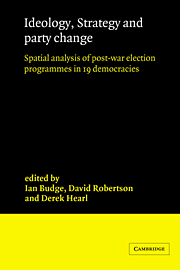 Ideology, Strategy and Party Change
Ideology, Strategy and Party Change Book contents
- Frontmatter
- Contents
- List of Tables
- List of Figures
- Preface
- 1 The influence of election programmes: Britain and Canada 1945–1979.
- 2 The internal analysis of election programmes.
- 3 Britain, Australia, New Zealand and the United States 1946–1981, an initial comparative analysis.
- 4 Canada 1945–1980: party platforms and campaign strategies.
- 5 Sri Lanka 1947–1977: elite programmes and mass politics.
- 6 Israel 1949–1981.
- 7 Ireland 1948–1981: issues, parties, strategies.
- 8 Northern Ireland 1921–1973: party manifestos and platforms.
- 9 Sweden and Denmark 1945–1982: election programmes in the Scandinavian setting.
- 10 The Netherlands 1946–1981.
- 11 Belgium 1946–1981.
- 12 Luxembourg 1945–1982: dimensions and strategies.
- 13 Austria 1945–1978.
- 14 Electoral programmes in West Germany 1949–1980: explorations in the nature of political controversy.
- 15 France 1958–1981: the strategy of joint government platforms.
- 16 Italy 1946–1979: ideological distances and party movements.
- 17 Japan 1960–1980: party programmes in elections.
- 18 Do parties differ, and how? Comparative discriminant and factor analyses.
- Appendices
- General bibliography
- Index
4 - Canada 1945–1980: party platforms and campaign strategies.
Published online by Cambridge University Press: 27 October 2009
- Frontmatter
- Contents
- List of Tables
- List of Figures
- Preface
- 1 The influence of election programmes: Britain and Canada 1945–1979.
- 2 The internal analysis of election programmes.
- 3 Britain, Australia, New Zealand and the United States 1946–1981, an initial comparative analysis.
- 4 Canada 1945–1980: party platforms and campaign strategies.
- 5 Sri Lanka 1947–1977: elite programmes and mass politics.
- 6 Israel 1949–1981.
- 7 Ireland 1948–1981: issues, parties, strategies.
- 8 Northern Ireland 1921–1973: party manifestos and platforms.
- 9 Sweden and Denmark 1945–1982: election programmes in the Scandinavian setting.
- 10 The Netherlands 1946–1981.
- 11 Belgium 1946–1981.
- 12 Luxembourg 1945–1982: dimensions and strategies.
- 13 Austria 1945–1978.
- 14 Electoral programmes in West Germany 1949–1980: explorations in the nature of political controversy.
- 15 France 1958–1981: the strategy of joint government platforms.
- 16 Italy 1946–1979: ideological distances and party movements.
- 17 Japan 1960–1980: party programmes in elections.
- 18 Do parties differ, and how? Comparative discriminant and factor analyses.
- Appendices
- General bibliography
- Index
Summary
Nowhere more than in Canada has printed election material been influenced by the electronic bias that increasingly dominates party campaign strategies. Long and relatively complex manifestos have been replaced by shorter pamphlets – themselves dominated by photographs and headlines. Though the responsibilities of government have become broader and more complex (indeed, partly because of this), the short-term stances of parties have been increasingly simplified and focused. The evolution in the style and format of party election documents in Canada is as striking as changes in their content and indeed, the two are related. In this chapter we shall examine both developments.
PARTIES AND DOCUMENTS
Our analysis covers the thirteen elections from 1945 to 1980. The dominant federal party during this period was the Liberal Party of Canada (Whitaker 1977). It held office from 1945 to 1957, winning parliamentary majorities in three successive elections. After a narrow electoral defeat in 1957, it resigned and was in opposition until 1963. Thereafter, it governed, confidently or precariously, until 1979. In 1963, 1965 and 1972 it could manage only a minority government. In 1968 and 1974, the party won parliamentary majorities. Its defeat in 1979 led to nine months in opposition, after which it returned to power. The fortunes of the Progressive Conservative Party, the main opposition party, are naturally the mirror image of this.
The supporting cast (‘supporting’ in a literal sense during periods of minority government) was made up of the CCF/NDP and the Social Credit parties.
- Type
- Chapter
- Information
- Ideology, Strategy and Party ChangeSpatial Analyses of Post-War Election Programmes in 19 Democracies, pp. 73 - 94Publisher: Cambridge University PressPrint publication year: 1987
- 4
- Cited by


